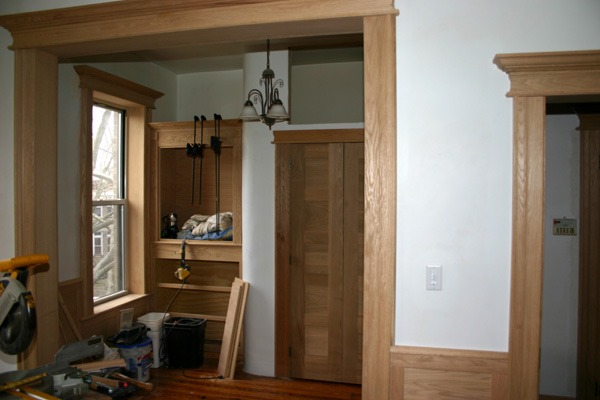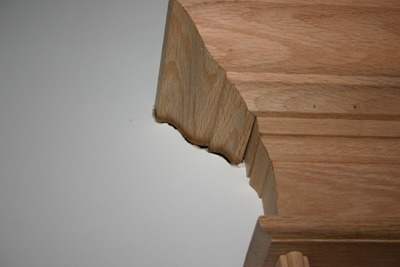I’ve been looking forward to this day for months. Almost all the trim, the doors, cabinets, etc are done! What’s “almost”?
By “almost” I mean that the center of operations moves downstairs to my shop. The remainder of the trim work — the cabinet doors and drawers, the panels under the bay window, the stained glass window, the overhead closet doors and even the curved baseboard moulding for the closet corner have to be fabricated. I need my stationary power tools for this stuff.
“Almost” also means that I need to make a decision about whether or not to incorporate bolection a/k/a rabbeted panel a/k/a panel inset moulding into the wainscotting. I couldn’t find this stuff at my local lumberyards or online and the router bits I ordered which I thought might work didn’t do a very good job of it. I’m hoping the router geeks at this weekend’s Somerset NJ Tool Show will have some answers for me.
PS: the closet doors look like a bad panel lamination job in this photo. Actually, they’re five panel doors. You just can’t see the rails very well in this shot.

“Almost” also means I haven’t made the lid for the top of that tall wainscotting yet. I haven’t decided whether or not to do that with oak plywood and a hardwood banding yet. It would save me a small bundle over 1×10 solid oak if I did.
“Almost” means that I have several days of sanding ahead of me, and probably a couple of not-so-skillfully-cut joints that will need to be hidden from critical eyes behind 3/8″ quarter-round.

We have a major snow storm coming Tuesday night, the same night as my garbage pickup, so that stuff probably won’t get collected for days. My friend around the corner said I could dump it in front of his place. His pickup is tonight and he’s been in Puerto Rico all week so he has nothing to put out. So clean-up is today’s priority.

PS: that little gap between the crown and the pediment below is for expansion. You need to be careful about making compound mouldings too tight during the dry winter months. Otherwise, a 90-degree, 98% humidity July day could result in that crown moulding corner splitting open.

